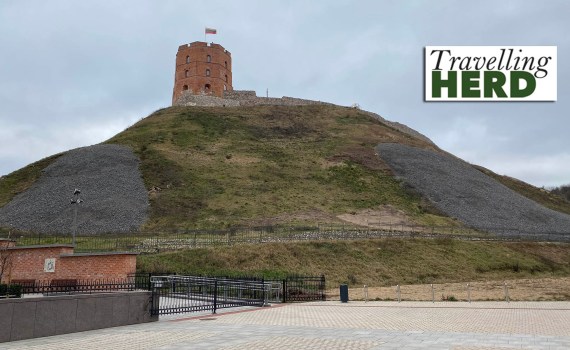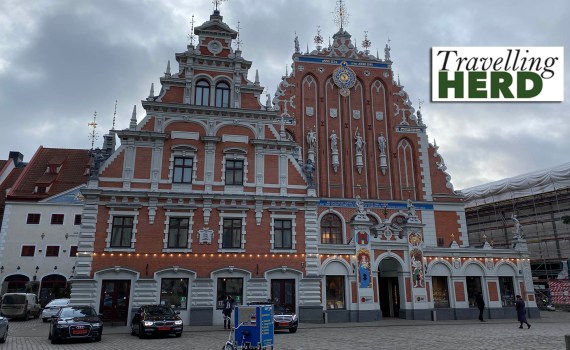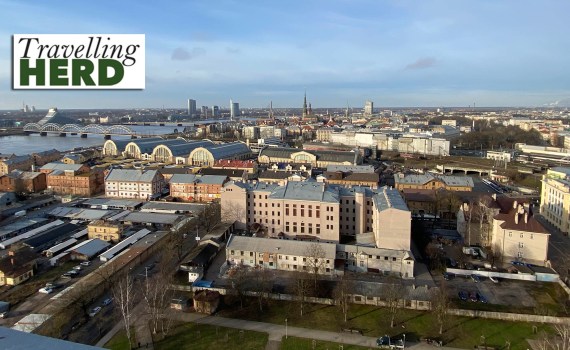Sunday 19th and Monday 20th January 2020 There is currently no direct train service between Riga and Vilnius and to travel to the Lithuanian capital by train involves leaving at 07:40 and going via Daugavpils with a four and a half hour wait for the connection on to Vilnius. We would therefore expect to spend about ten hours travelling and arrive at 18:24. In a rare departure from our usual preference for train travel, Matilda persuaded Robert that the executive coach service would be a better option as it would take us direct to Vilnius in less time than we would otherwise have been waiting for our connection. She felt entirely vindicated as, after a lie in, a trip to the hotel gym and a leisurely breakfast, she settled in to the spacious, comfortable, reclining seat which was to be hers for a mere four hours. On arrival, Robert obviously felt the need to sample the local ale in a new country and we went to Variokas. The bar is located in the cellars and has a steampunk theme as well as a good selection of local craft beers and some weird bits of tat as ornamentation [see the Video […]
Latvia
Saturday 18th January 2020 Today’s route first took us past the Powder Tower. Originally called the Sand Tower, this was built in 1330 as part of the city’s fortifications and defences. Over the centuries it has been rebuilt and redesigned several times, and it took on its current form in around 1650. It is a formidable defensive structure at 25.6 metres high and 14.3 metres in diameter with walls which are 3 metres thick. It takes its current name from the gunpowder which was stored there and it now houses a War Museum. Jacob’s Barracks – a row of yellow, red-roofed buildings – extends along Torna Street from the Powder Tower down towards St Jacob’s Cathedral and the River Daugava. It is the longest building in Old Riga. Baron Hieronymus Karl Friedrich von Münchhausen, who was the inspiration for the eponymous character in the fictional book Baron Münchausen’s Narrative of his Marvellous Travels and Campaigns in Russia lived here in the mid eighteenth century. The street is now home to bars, shops and travel agents. Jacob’s Barracks were built just outside the city fortifications and now face some remains of the city walls [below] and the Swedish Gate [not pictured]. […]
Friday 17th January 2020 Riga was part of the Medieval Hanseatic League – a confederation of merchant guilds and towns which dominated maritime trade in the Baltic for three centuries. Since then, the city has been subject to Swedish, Polish, Russian Empire, Nazi and Soviet rule. As you walk around the city you get a flavour of these various historical influences, although as we were to learn during the course of our visit, not all of the buildings are as old as you might think. Our hotel was close to Rātslaukums, the Town Square, and the imposing red granite monument to the Latvian Riflemen who defended Baltic territories against the Germans during World War I. Three riflemen stand back to back, facing outwards, ready to take on all who dare challenge them. Chiselled features and powerful physiques glorifying the proletariat are a common theme in Soviet art. However, as many of the riflemen went on to become Lenin’s personal bodyguards, some Latvians see the monument as an unwelcome reminder of the old communist system and would like to have it removed. There is a retro tram which runs at weekends but even the regular trams are not exactly state of […]
Thursday 16th January 2020 Although you can get a coach between the Estonian and the Latvian capitals, there is currently no direct train link between Tallinn and Riga: services go via Valga on the border. We had to rise early [we were first down to breakfast in our hotel] to catch a train from Tallinn to Valga for the first leg of the journey. Although the man at the ticket counter had suggested we might struggle to get a seat, once we were on board, we began to wonder whether he was being ironic. The scenery was predominantly trees and woodland. At the end of WWI, Valga was the only place that was disputed between Estonia and Latvia and a British mediator was called in to settle the dispute which he did by dividing the town in two. On the Latvian side, the town is called Valka. We arrived in Valga/Valka with three hours to wait before our onwards connection to Riga so we deposited our luggage in the lockers in the spacious railway station hall and went to stroll round the town. Valga promotes itself with the slogan, “One city, two states” and this is written prominently around the […]




